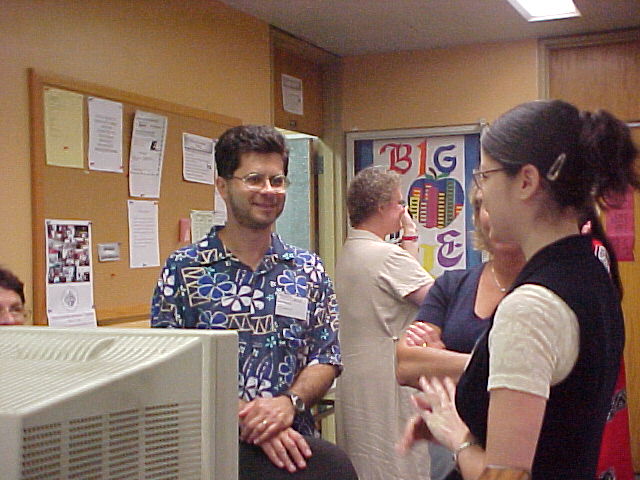In
Search of Dracula: History and Imagination
URL: http://teachersnetwork.org/teachnet-lab/fklane/dracula/dracula/indexdracula.htm
How
it works:
Starting with the image of Dracula as both historical and
supernatural character, this program takes the reader into the realm of
imagination seen across times, peoples, and types of cultural
products. The theme is the effect of supernatural beliefs
reflected in history, language, literature, and the arts. The program
is accessed easily by students
and teachers alike. In Search of Dracula is open-ended; many activities can be
added by the author or the students themselves. The user is taken to
various activities and directions that appeal to different forms of
learning: reading, brainstorming, writing, critical thinking, and others. You are invited to a presentation of sources and a discussion
on the supernatural and its mythical sources. Then you go to
the historical sources on Vlad Tepes, the real King of Wallachia who
seemed to have generated the Western image of Dracula. The students learn to evaluate sources,
understanding the difference
between primary and secondary sources, between facts and fiction, and reliable and unreliable
information. The evaluation component
will then be applied to Web-produced information, so that students
will know how to assess information downloaded from the Internet.
Other activities take the reader into the world of literature and the
arts. Fiction is intricately connected to the supernatural. The
students use Internet sources as well as Web-based activities
(quizzes and discussion forums) to learn more about mystery stories and
supernatural characters in novels and movies. Here, activities on literary
elements and the
reading and the writing processes (in accordance with the educational
standards in English) are useful. The Internet and the new forms of media are the keystone of this
entire learning piece. The format is accessible and user-friendly.
Students are invited to explore the topic on their own and construct their own instruments of learning and assessment using the
on-line layout.
Standards addressed:
Students listen, speak, read, and write for information and
understanding. They collect data, facts, and ideas; discover
relationships, concepts, and generalizations; and use knowledge
generated from oral, written, and electronically produced texts.
They listen, speak, read, and write for critical analysis and
evaluation; analyze experiences, ideas, information, and issues
presented by others using a variety of established criteria. They use
oral and written language that follows the accepted conventions of the
English language to present, from a variety of perspectives, their
opinions and judgments on experiences, ideas, information, and issues.
The students consider different historians' analyses of the same event
or development in history to understand how different viewpoints
and/or frames of reference influence historical interpretations. They
evaluate the validity and credibility of historical interpretations of
important events or issues in history, and revise their interpretations
as new information is learned and other interpretations are developed.
Materials used:
A computer lab with Internet connection and Microsoft Word is
required.
The students:
This program was used with an ESL student population that has at
least two years of schooling in the United States and is preparing for
the high school commencement exams in English, Social Studies, and
other disciplines. The unit also meets the needs of the mainstream student population in the areas of English and Social
Studies. As a prerequisite for full participation in these
activities, students need to become familiar with Internet navigation
and a word processor program such as Microsoft Word. Other
computer skills, such as the use of on-line tests, discussion forums,
and the making of simple Web pages, will be added later during the
execution of the required activities.
Overall value:
I found it very useful to write a program for teachers and
students on the basis of the fact that teaching is learning in another
way. Students should be offered challenging activities and be invited
to fully participate in the learning process. The diverse and open
character of this program invites teachers and students to rewrite, enrich, and assess the learning experiences contained here.
This program approximates the features of active learning: circular,
open-ended, motivational, diverse, and interdisciplinary. The Internet is the central medium of communicating information here.
I tried to include some lesser-known features:
Web tests, discussion forums, Web page assessment tools, and audio and
video streaming. Other Internet "gadgets" can be
added to the project as they prove to be necessary learning tools.
Most
activities contained here invite decentralization of instruction and
the use of multiple methods to teach and learn. The teacher will find
this a valuable resource in presenting important concepts in English
language and literature, as well as in Social Studies.
Tips:
The Web site of this project can be "played with." Allow
students to search, experiment, and follow the many links provided.
Then you can focus on a specific activity such as source evaluation,
the writing process, or the literary elements of a story (the
"deconstruction" of a mystery story). Every component has
plenty of support material in the form of links, tests, and suggested activities. I invite you and your
students to enrich and adapt this experience based on your own needs
and educational goals.
|

About the teacher:
Dinu Pietraru is an ESL teacher in a large high school in
Brooklyn, NY. He has used the Internet in instruction for several
years. Please see the school Web site Dinu maintains:
http://fklane.org
E-mail:
dpietraru@nyc.rr.com
Subject
Areas:
English Language Arts
SocialStudies
Grade
Levels:
10-12
|